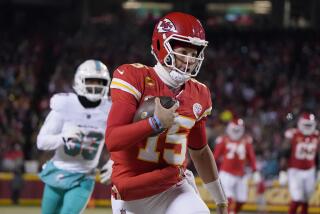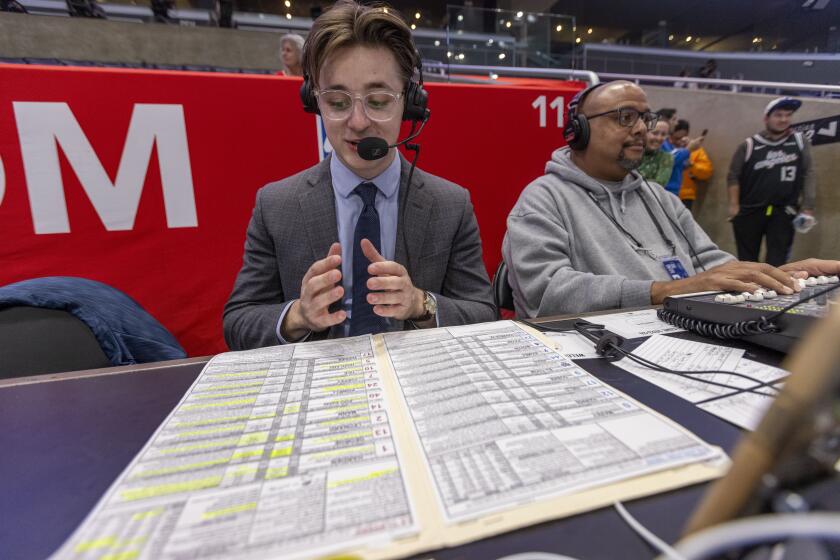Watching NFL games in 2020: A feast for the eyes and ears
Were the Green Bay-Pittsburgh Super Bowl being played in 2020, this might be the view from your living room:
You want to follow Troy Polamalu? Punch that information into your three-dimensional video display, and a glowing virtual disc appears under the Steelers safety and tracks his every movement.
You want to see how crisply Greg Jennings ran that route? Instruct the board to erase the players around him, and it’s as if the Green Bay receiver is running alone.
Every conceivable statistic, morsel of historical information and on-field camera angle is a few button pushes away. No wonder the NFL is so concerned about ramping up its in-stadium product; watching the country’s No. 1 sport at home is too comfortable, too convenient and much less costly.
“It’s always going to come down to, how do you make it more entertaining?” said Fred Gaudelli, producer of NBC’s “Football Night in America.”
“Everything we do will be done with, how can we make this more entertaining for the viewer? How can we tell the stories better? How can we have better pictures? How can we have better replays? It’s really about making it more compelling.”
And on what will that audience be watching? Experts agree standard-resolution TVs will soon go the way of black-and-white sets, as high definition becomes increasingly entrenched. But 3-D is also making inroads, and it’s too early to tell whether that will be the new standard or will be more of a fleeting trend.
David Hill, chief executive of Fox Sports, has said that football will eventually be watched at home on holographic televisions, allowing viewers to watch, say, the New York Giants and Tennessee Titans dialed down to the size of chess pieces or dialed up to the size of, well, giants and titans.
Hill has also talked about wealthier fans having some type of “environment rooms” in which they watch games at home, places where they could simulate various NFL environments — although it’s hard to believe anyone would try to mimic a bitter-cold day in Green Bay.
Already, people watch the NFL on phones, tablets, laptops and traditional TVs. ESPN’s Jay Rothman, producer of “Monday Night Football,” can envision a day when there will be separate broadcasts for hand-held devices that are distinctly different from those for television.
“I can see where Super Bowls would be produced differently for the phone, for computers and for television,” Rothman said. “I don’t think television is going to be the end-all, be-all feed.
“Think about the size of the screen on your phone. Are you going to be able to see a game camera on a screen that size? The hand-held feed might just be low-angle, tight, close-up feeds to fit your screen.”
The camera angle that Rothman says we’ll see even more of in the coming years is the overhead shot from the so-called Skycam or CableCam that’s suspended over the field by a web of wires. It’s logical to think there might one day be two of those in games, one over the offense and the other over the defense. As it is, however, those devices are big enough to get in the way of a thrown or kicked ball.
This much we know: The number of TV cameras at games will continue to rise, until there are enough to capture every inch of the field and sideline from every conceivable angle.
Gaudelli thinks that, for some viewers, watching football at home will become more active than passive, with the experience becoming increasingly customizable. Even now in broadcasts that stream online, the networks allow viewers to pick from an array of camera angles.
In the coming years, Gaudelli said, viewers will be able to access statistics during the game, replay highlights, watch the game from the end zone, cable camera . . . wherever. Current NFL Ticket subscribers already can access stats and scores with a push of a button.
“I want TV to be passive; when I’m home I don’t want to be producing a show,” Gaudelli said. “But there’s always going to be that group, and especially the younger generation, that may see it a different way.
“All the options will be there. You can continue to watch it the way you’ve watched your entire life, and 14-year-old Johnny will be able to watch it the way he wants to watch it.”
Gaudelli also thinks that in a few years it will be possible to digitally erase players in near-real time, in order to get a better look at a play. That’s done now by networks, but it can take anywhere from minutes to hours.
However, not everything about broadcasts is moving forward. When the NFL moved the umpire this season, bumping him from the middle of the defense to a spot behind the quarterback, it was a huge setback for TV.
Why? Because the umpire wore a microphone in games, allowing him to pick up the sound of the quarterback and defensive players making their calls at the line of scrimmage, and get the ambient noise of bodies colliding.
Broadcasts, Gaudelli said, “took a 20-year step backward when they moved the umpire. . . . From a pure television technological standpoint, right now we’re so handcuffed that we’re putting out sounds that are not remotely close to being state of the art in 2011. We don’t have any sounds.”
He said the league has allowed networks to experiment by putting microphones on the chest and back of the center, and that seems to work well. To this point, however, that isn’t mandatory for teams, and teams aren’t necessarily in favor of sending their audibles out on the airwaves.
Aside from that, this is the Golden Age for watching NFL games at home.
Could the Platinum Age be right around the corner?
twitter.com/latimesfarmer
More to Read
Get our high school sports newsletter
Prep Rally is devoted to the SoCal high school sports experience, bringing you scores, stories and a behind-the-scenes look at what makes prep sports so popular.
You may occasionally receive promotional content from the Los Angeles Times.







